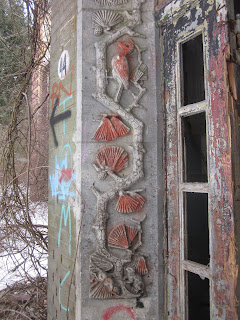According to Wikipedia, "Beelitz-Heilstätten, a district of the town, is home to a large hospital complex of about 60 buildings including a cogeneration plant erected from 1898 on according to plans of architect Heino Schmieden. Originally designed as a sanatorium by the Berlin workers' health insurance corporation, the complex from the beginning of World War I on was a military hospital of the Imperial German Army. During October and November 1916, Adolf Hitler recuperated at Beelitz-Heilstätten after being wounded in the leg at the Battle of the Somme. In 1945, Beelitz-Heilstätten was occupied by Soviet forces, and the complex remained a Soviet military hospital until 1995, well after the German reunification. In December 1990 Erich Honecker was admitted to Beelitz-Heilstätten after being forced to resign as the head of the East German government.
Following the Soviet withdrawal, attempts were made to privatize the complex, but they were not entirely successful. Some sections of the hospital remain in operation as a neurological rehabilitation center and as a center for research and care for victims of Parkinsons disease. The remainder of the complex, including the surgery, the psychiatric ward, and a rifle range, was abandoned in 2000. As of 2007, none of the abandoned hospital buildings or the surrounding area were secured, giving the area the feel of a ghost town. This has made Beelitz-Heilstätten a destination for curious visitors and a film set for movies like The Pianist from 2002, the Rammstein music video "Mein Herz brennt" and "Valkyrie" from 2008."
Some friends and I decided to take a trip out to this Sanitorium on Easter Day, one of the (hopefully) last snowy days of the year. It's about 45 minutes on the regional train from Berlin, so quite an easy and cheap journey if you get the Berlin Brandenburg Ticket!
Here is the entrance to the first building we entered, the campus is HUGE, so we only had time to check out the Northwest corner.
As soon as we enter we were greeted by these stairs...
...and this long, creepy corridor.
Inside this big circular room there was a lot of interesting graffiti.
We also found a surgical table and all this surgical equipment, including an IV fluid container, a syringe, gloves, tubes and scrubs. We're not sure if these were legit, or if maybe someone brought them in and left them there as part of a film project, as we didn't find this stuff anywhere else, but it was a bit creepy.
More graffiti in the room.
We continued wandering, but clearly we were not going up THESE steps!
Since the hospital was run by Soviets, all the official text all over the buildings was in Russian.
Maybe not the most comfortable sleeping space. I'm not sure what these rooms were for, but it looked like people had been squatting here at some point, as there were lots of mattresses strewn about the floor.
Someone left their mark.
Possibly the most uncomfortable-looking sleeping space. Note the egg containers?
No more electric.
Stained glass windows have seen better days...
Outside the entrance to the building, these buildings had lots of details and must have been absolutelz beautiful before nature took its toll.
Sometimes there was no real floor.
My urban exploring crew!
Must have been the children's room.
The Worst Toilet in Germany?
More Russian, this was above what must have been sinks or bathing basins.
We found an elevator removed and just left in the middle of the floor. We decided it was now a time machine. This is what you do in a time machine, clearly.
The boxes from some old drugs were still there and strewn about.
This room had tons of lists of drugs in Russian, charts and this old fridge, which I imagine was used to keep the medicine cold.
Cathy!
The lists of what we imagine must be drugs, but it's in Russian, so your guess is as good as mine.
I never claimed to be mature.
Some old wallpaper clinging on for dear life.
The ceilings of another building. The architecture of the buildings was really quite fantastic.
We went in another, likely older building. It looked like it had been through a significant fire. What was interesting, though, is that while all the other buildings had graffiti in German or English, the graffiti here was all in Russian. I imagine it must have been abandoned earlier while the Soviets were still using other buildings. If you look the dates here are 79'-80. I imagine, in that case, it was already abandoned then!
More Russian graffiti, 1972, 1977 and 2008.
This building was definitely quite decrepit.
This is what I meant by a significant fire. Parts of the hallway were totally black.
We're not sure what this room was, maybe a ball room, as it would have been quite fancy.
Antifa: Smash Facism
I found this entrance to a tunnel. No one wanted to go with me, but eventually Cathy and Karla came, and we realized the tunnel only led a short distance to the other side of the outside area.
The first room we stumbled upon after entering the older building where everything was in Russian. Lots of people were here!
There you have it. We definitely want to go back and explore the other sections, but with so many buildings and so much area to cover, we didn't have enough time in one trip!




































No comments:
Post a Comment